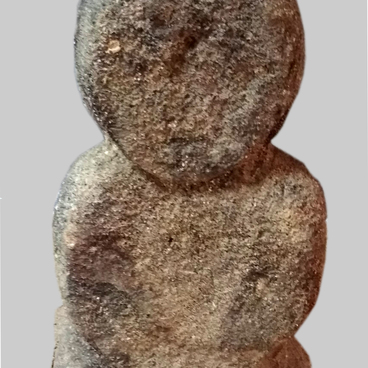In 1900, peasant V. M. Govorukhin found a hoard of twenty bronze figurines while plowing a field near the village of Sapogovo. Two of them were lost immediately. Ten more figurines that V. M. Govorukhin sold to peasant V. S. Fedorov were seized by the Imperial Archaeological Commission and transferred to the State Hermitage Museum. Some 28 years later, Govorukhin’s widow revealed the existence of ten more figurines. She sold two figurines to unknown persons and six to the Sverdlovsk Museum.
A bronze figurine identical to the ones from the SapogOvo hoard was accidentally found near the village of Elevator in the KunashAksky District of the ChelyAbinsk Region in 1985. The figurine is 11.6 centimeters high. Its legs are broken below the knees, a defect that it sustained back in ancient times. The head is large and disc-shaped, with eyes in the form of small round bumps. The nose is long, strongly protruding, and slightly humped. The rounded chin protrudes forward under the cheeks. The neck is of normal length. The body is flat, wide, quadrAngular, with protruding breasts in the form of round bulges. The arms are arched and pressed to the hips. The long slender fingers of the right hand are widely spaced, with the thumb and forefinger straight and the rest of the fingers bent. The left hand is missing: it may be a manufacturing defect, or the figurine may have been deliberately made one-handed.
Judging by what remains of the legs, they were bent at the knees and spread apart. Sexual characters are missing. A dagger with a straight crossguard and a straight pommel is schematically depicted on the right thigh.
Just like the other figurines from the Sapogovo hoard, this figurine was made in a double-sided casting mold using a preliminary model carved out of wood. Their front side was carefully processed, and the back was smooth (with traces of a fibrous wood structure). The metal mass is bubbly, the surface is rough, and the mineral crust is dense, matted, and grayish green.
Llike other figurines from the Sapogovo hoard, the figurine from the village of Elevator dates back to late 1st–2nd century BC.
A bronze figurine identical to the ones from the SapogOvo hoard was accidentally found near the village of Elevator in the KunashAksky District of the ChelyAbinsk Region in 1985. The figurine is 11.6 centimeters high. Its legs are broken below the knees, a defect that it sustained back in ancient times. The head is large and disc-shaped, with eyes in the form of small round bumps. The nose is long, strongly protruding, and slightly humped. The rounded chin protrudes forward under the cheeks. The neck is of normal length. The body is flat, wide, quadrAngular, with protruding breasts in the form of round bulges. The arms are arched and pressed to the hips. The long slender fingers of the right hand are widely spaced, with the thumb and forefinger straight and the rest of the fingers bent. The left hand is missing: it may be a manufacturing defect, or the figurine may have been deliberately made one-handed.
Judging by what remains of the legs, they were bent at the knees and spread apart. Sexual characters are missing. A dagger with a straight crossguard and a straight pommel is schematically depicted on the right thigh.
Just like the other figurines from the Sapogovo hoard, this figurine was made in a double-sided casting mold using a preliminary model carved out of wood. Their front side was carefully processed, and the back was smooth (with traces of a fibrous wood structure). The metal mass is bubbly, the surface is rough, and the mineral crust is dense, matted, and grayish green.
Llike other figurines from the Sapogovo hoard, the figurine from the village of Elevator dates back to late 1st–2nd century BC.



